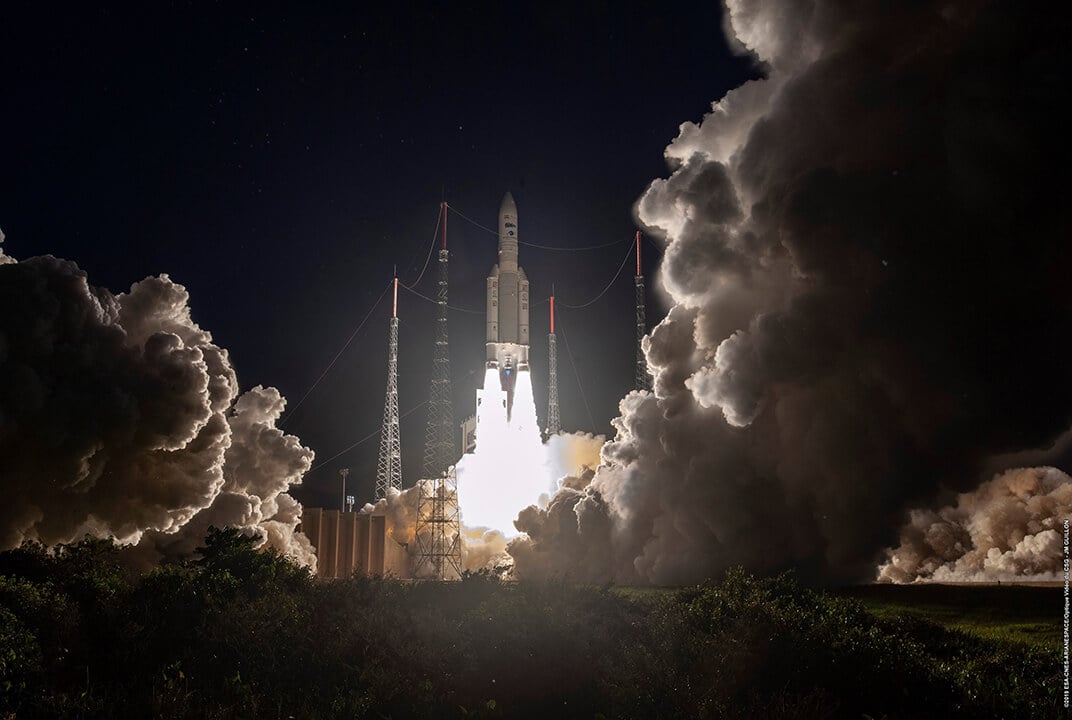Insight | A unique spacecraft
A unique spacecraft
null
Understanding the unique design elements that enable GX5 to deliver unprecedented amounts of performance to Inmarsat’s Ka-band customers.
GX5 recently entered commercial service, marking a huge step forward for Inmarsat as we begin to deliver on the commitments that we made with our technology roadmap. Designed specifically for the busy corridor between Europe and the Middle East, this exceptional satellite brings reliable, seamless high bandwidth broadband to our aviation, maritime and government customers where they most need it.
“Besides capacity, a key role of GX5,” explains Inmarsat CTO, Peter Hadinger, “is that it forms an evolutionary bridge for us between the original Inmarsat-5 spacecraft and the soon to be coming Inmarsat-7 spacecraft”. It does this by introducing key new technologies that enable higher throughput into the aircraft and maritime vessels that we serve.
A whole lot of capacity
All this new technology translates to substantial extra Global Xpress capabilities - in fact, GX5’s capabilities are more than that of the entire existing GX1-4 fleet combined. And all this capacity comes in a smaller footprint - GX5’s beams cover only 25% of the area of one of the existing GX satellites. GX5 also operates via six ground stations to receive the satellite’s signal and transmit it via antennas to provide broadband connectivity. GX1-4 each require only two ground stations, so why does the new satellite need so many more?
“The extra capacity available from GX5 is so significant, that we can't bring it down in one feeder link,” explains Gerard Luursema, Inmarsat Senior Director, Global Ops Evolution and Programmes. “With GX1-4, we are able to bring all of their capacity down to one dish in one location, with a second built for redundancy purposes. With this satellite however, we need four feeder links to get all the bandwidth down from the user terminals.
“The new satellite was designed so that we have redundancy in pairs of two,” continues Luursema. “Each pair directs its redundancy to one sister location. This allows each of them to fail over to the backup site and gives us two combinations of three sites that work together closely.”
A frequency reuse scheme is used, so available spectrum can be used multiple times over the satellite footprint. As a result, meticulous planning was required to choose the right ground sites and feeder links as part of the design process.
Perfectly formed ground coverage
One of the key benefits of a geostationary earth orbit (GEO) constellation is that the satellite appears to be in the same place in the sky continuously. GEO satellites remain in orbit at 36,000 kilometres above the Earth’s surface and the beauty of this position is that they circle around the Earth at the same pace as the Earth moves. This effectively means that our antennas remain pointed at the same satellite all the time, which is not the case with low Earth orbit (LEO) satellites.
“LEO satellites appear a little bit like planes in the sky, they move from west to east or from north to south,” explains Luursema. “It can take hundreds of LEO satellites to cover the earth, yet we can offer global coverage with just three GEO satellites,” he expands.
With multiple satellites to follow, ground station antennas constantly have to search the horizon to pick up a LEO satellite and then move to the other side of the trajectory on the other horizon to pick up the next satellite’s signal. This requires multiple antennas to keep up with the orbital motion, which inherently results in a more expensive and more vulnerable ground network.
All those moving antennas in locations around the world have the potential to suffer from faults, whereas our smaller ground network means that we can really pay attention to those that need to be serviced with the redundancy available to ensure continuous connectivity.
Many of our maritime customers say the connectivity we provide is vital for crew welfare. Donald Lee, Procurement Manager at Orion Ship Management Pte Ltd, echoes these sentiments, “It was important for our seafarers to remain in contact with their family so that they stay in control of their lives and minimise missing out on important family events. We found Inmarsat’s Crew Xpress and Fleet Hotspot to be a perfect solution for our crew to stay connected to their loved ones from their own device while at sea.”
Nothing like a global network
There’s been talk about the GEO networks having a latency limitation due to their distance from the Earth and by that, we are referring to a half second round-trip delay. Because the view of GEO satellites can skip over so much of the Earth, we avoid the terrestrial fiber and inter-satellite delays that make up most of the latency in a real LEO network, making the actual difference quite small. When it comes to data connections, there’s much you can do to optimise network configurations which make those milliseconds imperceptible.
“The benefits of a global, reliable network far outweigh such a tiny delay,” substantiates Luursema. “As soon as you surf web pages, download a file or start to stream video, like Netflix for example, that delay is unnoticeable and irrelevant,” he continues.
The plan continues to unfold
As our fully funded technology roadmap unfolds, we will introduce even faster, more reliable, full function, long-term satellites that will offer truly resilient global coverage well into the future, as well as the ability to apply increased capabilities to target areas for our customers. Will the next seven satellites need similar investment in ground stations?
It’s unlikely that future satellites will need the same level of ground infrastructure as was required for the backwards compatible GX5, which performs a bridging task between existing satellites and future technology. Future satellites are predicted to need fewer ground stations, as new feeder link bands will be explored, which will be capable of even higher bandwidth.
The complex selection criteria for GX5’s six ground station sites also took future satellite needs into consideration. Only the best partners were selected, and these relationships will extend to the requirements of future satellites – after all, we’re executing a fully-funded and defined roadmap for the future.
Now, let’s take a look at what happens at our ground stations…
We talk to Guido Di Stefano, Fucino SAS Manager, about just what happens at two of GX5’s pioneering ground stations – Fucino in Italy and Cheia in Romania.
Can you give us an outline of what happens day to day at the Fucino and Cheia sites?
All GX5 gateway antennas are controlled remotely by our engineers at our Network Operations Centres (NOC) in London and Burum, 24 hours a day, seven days a week.
They ensure the ground stations are running at their optimum and if any maintenance or adjustments are required on site, or if any alarms raised, there are contracted site controllers located on each station, that offer support on site.
The travel restrictions put in place due to COVID-19 have meant that we have depended on our local contractors more than ever, to help with things like testing in our absence. Our great partnerships and solid procedures have enabled us to continue running our services remotely as smoothly as ever.
Can you please provide details of the antenna size and capability?
Both the Cheia and Fucino ground stations have the same type of antenna, which is 9.2 m in size.
The difference between these two ground stations, is that Fucino also has Telemetry, Tracking and Command (TT&C) capabilities, which ensure that our satellites perform correctly. Our Burum site also has TT&C capabilities.
Fucino is also the first of our ground stations that is capable of receiving V-band signals, which are in a higher frequency range than Ka-band signals. We are currently testing the use of V-band as we look towards connectivity needs in the future.
How long does an antenna take to build and install?
The antennas take three months to build and six months to install. We work closely with our expert partners to build and install our satellites.
Does all this capacity mean more data handling equipment at each ground site?
In fact, GX5 requires less equipment inside each ground site than any of our previous satellites. In part this is due to advances in technology that cram more processing into smaller packages, but it is also because Inmarsat is using GX5 to introduce virtualization into our network. Much of what had to be done on-site in the past is now done in software residing at large data centres at major Internet hubs. This makes it easier for us to roll out new capabilities across the network and to maintain the equipment. It also means less power draw – which is good for the environment (and the temperature inside the site!)


